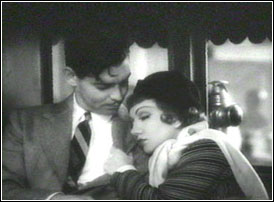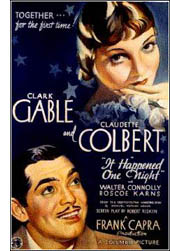|
As in so many of Capra's films,
the only thing that saves Peter and Ellie from their own misguided efforts
at self-defense is the emotional confusion they generate in each other.
It is only by virtue of their mutually induced bewilderment that the psychological,
social, and stylistic barriers behind which they try to protectively immure
themselves are undermined. The sexual "walls of Jericho" (in
the form of a blanket that  separates
their beds in several motel rooms) do suddenly come tumbling down at the
end of the film, but the far more important walls in the film are the
stylistic walls that Peter and Ellie erect around themselves, which are
comically chipped away at in the course of it. Both of them begin the
film by deliberately fleeing from the narrow, restrictive roles imposed
upon them by others, Ellie fleeing from her father's authority, Peter
from his editor's–only, in effect, to typecast themselves in a series
of equally rigid and confining new roles as they board the bus to New
York. It is by dint of bouncing off each other (literally and figuratively)
on a three-day bus trip that they stimulate productive doubts and confusions
in each other and in themselves and gradually learn to move away from
their initial states of stylistic mastery and psychological complacency.
They worry each other into creativity. separates
their beds in several motel rooms) do suddenly come tumbling down at the
end of the film, but the far more important walls in the film are the
stylistic walls that Peter and Ellie erect around themselves, which are
comically chipped away at in the course of it. Both of them begin the
film by deliberately fleeing from the narrow, restrictive roles imposed
upon them by others, Ellie fleeing from her father's authority, Peter
from his editor's–only, in effect, to typecast themselves in a series
of equally rigid and confining new roles as they board the bus to New
York. It is by dint of bouncing off each other (literally and figuratively)
on a three-day bus trip that they stimulate productive doubts and confusions
in each other and in themselves and gradually learn to move away from
their initial states of stylistic mastery and psychological complacency.
They worry each other into creativity.
This is exactly where a Hawks
screwball comedy would end: Unpredictability and eccentricity would have
been allowed in to loosen up and lubricate other wise rigid and confining
social performances. This is also where most accounts of Capra's films
stop. This, however, is where Capra's idealistic form of screwball comedy
differs from the garden-variety Hollywood form. Capra suggests that even
these new performances, however iconoclastic they may be, are themselves
still potentially only further dead ends to development, traps for the
free imagination, or if not dead ands and traps, then still only rather
frivolous and trivial expressions of the self. His films stand as a radical
critique of the aesthetic premises of the Hawks and Lubitsch comedies.
One must move beyond these new social roles, but how does one move beyond
the limitations of all social roles, beyond all technical acting performances?
Of course, one way of remaining
free from limiting styles and confining roles is to adopt Peter's initial
cynicism about all social relationships and commitments. As in so many
of Capra's other films, from Platinum Blonde on, the reporter character
is a representation of postmodern man in all his glory and despair. He
is someone who, by virtue of his occupation, has become an ideal deconstructionist
of all of the texts of his own society. In being able to circulate freely
through his society's various social, political, and institutional special-interest
groups, as a reporter, he has recognized the arbitrariness and artificiality
of their codes of behavior. Indeed, that truth has made him free. Yet
however dazzling his freedom and mobility may seem, they, like that of
all literary and cultural deconstructionists, are earned at the price
of sacrificing moral and social involvement and belief, and with them
the possibility of enduring personal or moral commitment. The postmodernist
figure is, like Peter at the beginning of the film, the playful, detached,
master of all roles and movements, except those that would compel him
to sacrifice this mastery and movement–such as intimacy, commitment,
or love of another human being.
In the largest sense, Capra
forces his master performers in these films to acknowledge deeper emotional
needs and commitment that bring their consummate mastery of performance,
their brilliantly mercurial shifts of tones and styles, into question.
They are compelled to realize that they have selves underneath all of
the roles that may not be satisfied or expressed by them. Although Peter
is not as extreme a case as Florence Fallon, Capra suggests that he too
has ideals and feelings that are not being expressed by his virtuosic
social and theatrical powers of performance. His capacities to "play"
(socially and theatrically) make him wonderfully entertaining, but Capra
wants to suggest that there is a self (or a set of beliefs and desires)
underneath all of the play that is separate from it, and ultimately not
satisfied by it.
Consider the scene in the hayfield,
which comes about twenty five minutes after the one in the motel. Peter
and Ellie have been forced off the bus by a breakdown and have been trekking
cross-country, with Peter playing to the hilt the role of the cocky, wisecracking
male protector to which he has repeatedly reverted. (He has been protecting
himself from emotional vulnerability by hiding behind a series of wisecracks
and sarcastic remarks, giving Ellie lessons in donut dunking and piggyback
carrying, just as he will on the following morning give her one on hitchhiking.)
Ellie is playing the role she habitually assumes of independent, liberated,
unshockable woman. The point Capra is making is how far from being truly
exploratory or creative this role playing is. (Though most audiences seem
to find it hilarious, I must say that it is not even very funny, in my
opinion, but increasingly tedious.) Their behavior is, in brief, only
a form of social wall building and emotional self-protection.
 Capra's
photographic and acoustic additions to the mere script of the film–what
is expressible in terms of the plot and dialogue–become his way of gesturing
beneath the fairly superficial social and theatrical text, or even, at
times, of indicating the irrelevance of everything we are watching being
played out on the social surface of events. This passional, stylistic
subtext is brought into existence through Capra's use of effects of lighting
and sound that are the rough equivalent of Joyce's mimetic shift to poetic
language and aurality. There are, at important moments in Capra's work,
in effect, two films superimposed one on top of another: the obvious one,
which we can, for convenience, call the text of the dialogue and plot,
and a quite different emotional subtext that is frequently covered up
or hidden by the first text. The part of the film represented by the smart
chat, comic routines, and games between Peter and Ellie is, we are made
aware, all a dodge, an evasion of an emotional and imaginative subtext
that neither character wants to be the first to disclose to the other.
In the haystack scene, all the while Peter and Ellie are emoting about
their toughness and independence, Capra's lighting on the haystacks and
cornfields and on Ellie's hair and face, the gauzed close-ups of her face,
and, most of all, the registration on the sound tack of all of the pregnant
pauses and silences between the two of them communicate the opposite of
their toughness, independence, and self-sufficiency. Capra's
photographic and acoustic additions to the mere script of the film–what
is expressible in terms of the plot and dialogue–become his way of gesturing
beneath the fairly superficial social and theatrical text, or even, at
times, of indicating the irrelevance of everything we are watching being
played out on the social surface of events. This passional, stylistic
subtext is brought into existence through Capra's use of effects of lighting
and sound that are the rough equivalent of Joyce's mimetic shift to poetic
language and aurality. There are, at important moments in Capra's work,
in effect, two films superimposed one on top of another: the obvious one,
which we can, for convenience, call the text of the dialogue and plot,
and a quite different emotional subtext that is frequently covered up
or hidden by the first text. The part of the film represented by the smart
chat, comic routines, and games between Peter and Ellie is, we are made
aware, all a dodge, an evasion of an emotional and imaginative subtext
that neither character wants to be the first to disclose to the other.
In the haystack scene, all the while Peter and Ellie are emoting about
their toughness and independence, Capra's lighting on the haystacks and
cornfields and on Ellie's hair and face, the gauzed close-ups of her face,
and, most of all, the registration on the sound tack of all of the pregnant
pauses and silences between the two of them communicate the opposite of
their toughness, independence, and self-sufficiency.
The most important scenes in
It Happened One Night redirect our attention away from the
actions and social interactions taking place and toward something
else that is apparently expressible only by the pauses between the words,
the tones of voice used, the quality of the light on a character's face.
The sounds in the background, or the musical orchestration on the sound
track. At such emotionally charged moments the characters often are saying
or doing nothing, or nothing very important–are silent, passive, or merely
staring thoughtfully into the distance, in reverie or meditation–and
we, too, shift into a meditative state....
This page only
contains excerpts and selected passages from Ray Carney's American
Vision: The Films of Frank Capra. To obtain the book from which this
discussion is excerpted, click
here.
|










